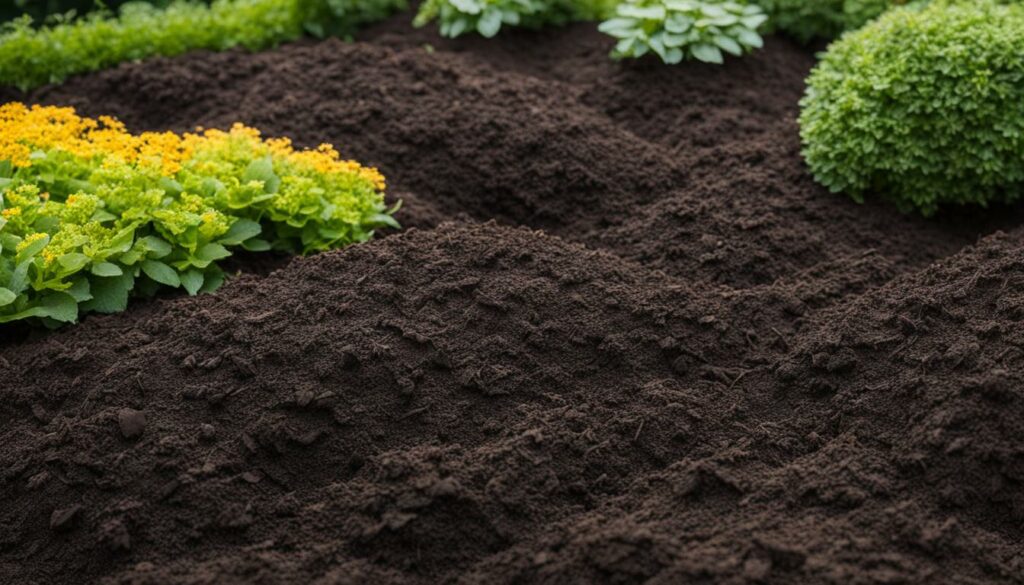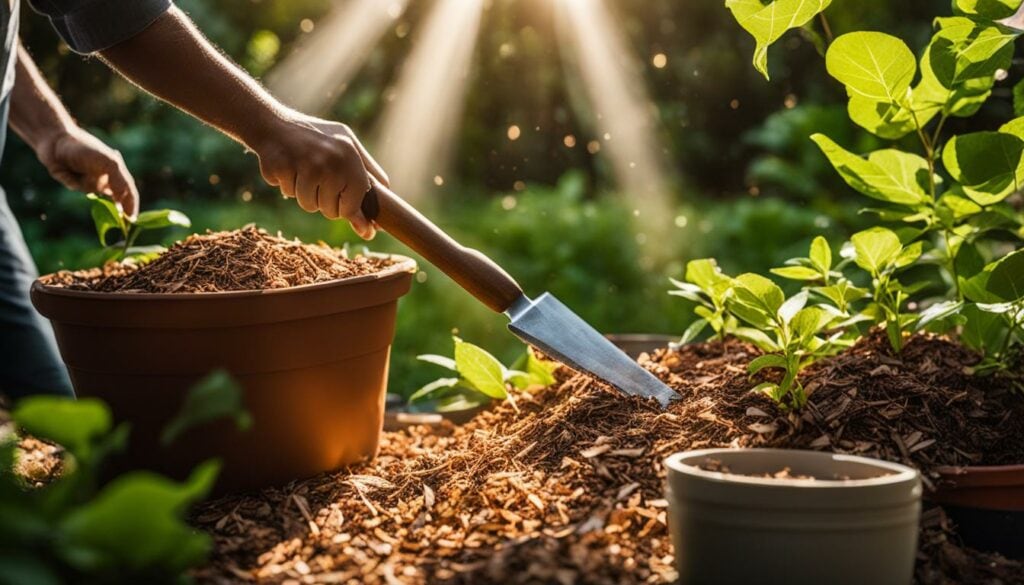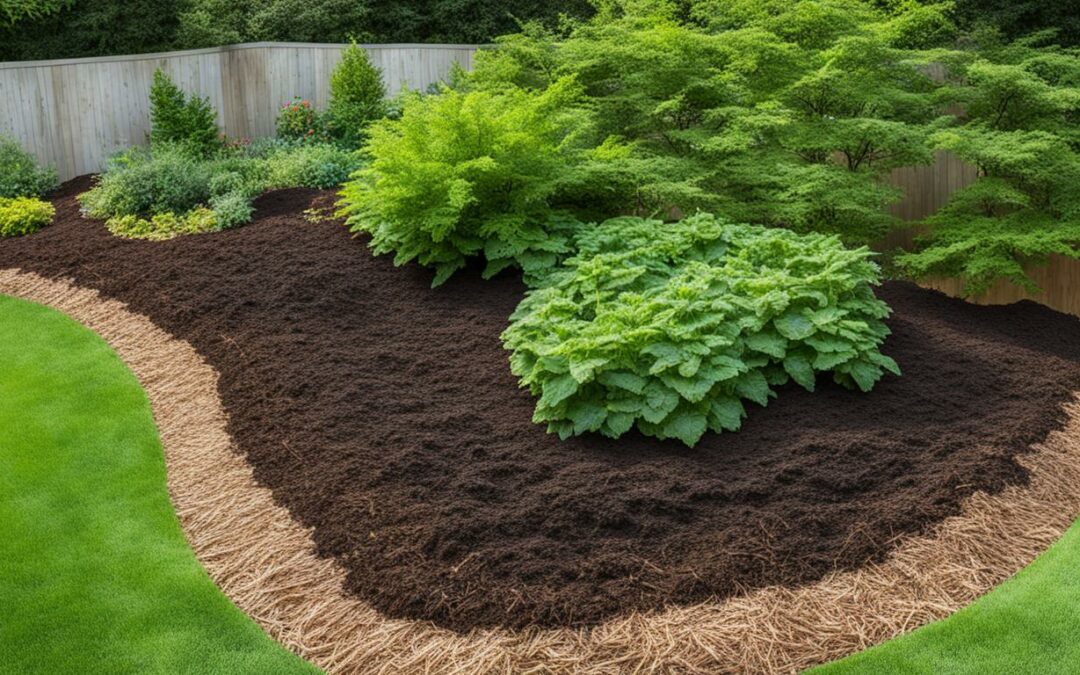Table of Contents
Key Takeaways:
- Mulching is a gardening technique that involves covering the soil with a layer of organic or inorganic material.
- It helps suppress weeds, retain moisture, improve soil quality, and protect plant roots.
- There are different types of mulch to choose from, including organic and inorganic options.
- Proper mulching can promote weed suppression, moisture retention, and overall soil health.
- By choosing the right mulch and applying it correctly, you can create a healthy environment for your garden to thrive.
The Benefits of Mulching
Mulching offers a range of benefits for your garden. Firstly, it helps to suppress weeds by blocking their access to sunlight, which prevents their growth. Secondly, mulch acts as a natural insulator and helps the soil retain moisture, reducing the need for frequent watering. It also helps to improve the soil quality by adding organic material as it decomposes over time. This enriches the soil and provides essential nutrients for plant growth. Additionally, mulching can help regulate soil temperature, protecting plant roots from extreme heat or cold. Whether you choose organic or inorganic mulch, both types can contribute to overall soil health and nutrient availability.
Mulching not only controls weeds but also helps conserve water in your garden. By forming a barrier between the soil and air, mulch reduces evaporation, thus maintaining soil moisture and reducing the need for frequent irrigation. Organic mulches, such as grass clippings or wood chips, break down slowly over time, releasing nutrients into the soil and acting as a natural soil conditioner. Inorganic mulches, such as plastic or rubber, do not decompose and can last longer, providing a longer-lasting weed barrier. Both types of mulch help to reduce weed competition and create a more favorable environment for plant growth.
Furthermore, mulching provides insulation to plant roots, protecting them from extreme temperatures. In hot weather, mulch can help to keep the soil cooler by shading it from direct sunlight. In colder climates, mulch acts as a blanket, keeping the soil warmer and providing a more stable environment for root growth. By maintaining a consistent soil temperature, mulch helps plants establish and thrive.
| Benefits of Mulching | Organic Mulch | Inorganic Mulch |
|---|---|---|
| Suppresses weeds | Yes | Yes |
| Retains moisture | Yes | Yes |
| Improves soil quality | Yes | No |
| Regulates soil temperature | Yes | Yes |
| Provides nutrients | Yes | No |
Choosing the Right Mulch
When it comes to mulching your garden, selecting the right type of mulch is crucial for its effectiveness and overall aesthetic appeal. There are various options available, including organic and inorganic mulches, each with its own advantages.
Selecting Organic Mulch
Organic mulch is derived from natural materials such as wood chips, bark mulch, or shredded leaves. This type of mulch is beneficial for improving soil quality, providing essential nutrients, and promoting healthy plant growth. Organic mulch also helps to retain moisture and suppress weed growth, creating a favorable environment for your plants.
Exploring Inorganic Mulch
Inorganic mulch, on the other hand, is made from materials like plastic or rubber. It offers a longer lifespan and is excellent for weed control. While inorganic mulch may not provide the same soil improvement benefits as organic mulch, it is a low-maintenance option that can enhance the appearance of your garden.
When choosing between organic and inorganic mulch, consider the specific needs of your plants and the overall look you want to achieve. For example, organic mulch is well-suited for garden beds and areas where you want to promote soil health, while inorganic mulch can be ideal for pathways or decorative areas.
| Mulch Type | Benefits | Examples |
|---|---|---|
| Organic Mulch | – Improves soil quality – Provides nutrients – Retains moisture – Suppresses weeds |
Wood chips Bark mulch Shredded leaves |
| Inorganic Mulch | – Low-maintenance – Enhances appearance – Controls weeds |
Plastic Rubber |
Remember to apply mulch at the recommended depth around plants. For trees and shrubs, a thick layer of mulch around the base can help retain moisture and protect their roots. Perennials, on the other hand, require a thinner layer of mulch, typically around 2 inches deep.
By choosing the right mulch for your garden and understanding how to apply it correctly, you can create an environment that promotes healthy plant growth, conserves moisture, and enhances the overall beauty of your outdoor space.

How to Apply Mulch Correctly
Properly applying mulch is essential to maximize its benefits in your garden. Follow these steps to ensure you apply mulch correctly:
Step 1: Prepare the area
Before applying mulch, prepare the area by removing any existing weeds or debris. This will create a clean surface for the mulch to be applied.
Step 2: Choose the right mulch
Consider using organic mulch, such as wood chips or compost, for optimal soil improvement. Wood mulches made from natural recovered forest materials offer a rich color that can last up to a year, sprucing up your landscape while improving your plants’ environment.
Step 3: Apply the mulch
Spread a layer of mulch that is approximately 2 to 3 inches thick over the soil. Be sure to leave some space around the base of plants to allow water and air to reach their roots. Use a rake or hand trowel to spread the mulch evenly and lightly tamp it down.
Step 4: Maintain the mulch
Regularly check for weeds and reapply mulch as needed to maintain its effectiveness in preventing weed growth. Mulch helps conserve water by reducing evaporation and blocking weed growth while improving air circulation in the soil.
By following these steps, you can properly apply mulch in your garden and create an environment that promotes healthy plant growth.

| Type of Mulch | Description |
|---|---|
| Wood Chips | Made from natural recovered forest materials, offers rich color and lasts up to a year. |
| Compost | Organic material that enriches the soil as it decomposes over time. |
| Straw | Great for vegetable gardens, helps retain moisture and prevents weed growth. |
| Rubber | Inorganic mulch that is long-lasting and effective in weed control. Environmentally friendly options are available. |
Enhancing Your Garden with Mulch
Adding mulch to your garden can transform its appearance and provide numerous benefits. Mulch not only adds a polished look to your landscape beds but also serves as a protective layer for the foundation of your home. It helps maintain the health of your trees and shrubs, as well as your garden beds.
Consider using colored mulches, such as Scotts® Nature Scapes® Color Enhanced Mulch or Scotts® Nature Scapes® Triple Shred Mulch, to elevate the aesthetics of your garden. These mulches come in a wide range of hues that can complement the colors of your home and flower gardens, enhancing the overall curb appeal of your property.
Aside from its visual appeal, mulch plays a crucial role in soil improvement. It helps regulate soil temperature, conserves moisture, and prevents weed growth. By creating a protective barrier, mulch keeps the soil temperature more stable, allowing your plants to thrive in a suitable environment. Additionally, it assists in moisture conservation, reducing the need for frequent watering and promoting healthier plant growth. The layer of mulch also acts as a natural weed deterrent, blocking their growth and reducing the need for manual weed removal.
So, whether you want to spruce up your garden’s appearance or improve its overall health, incorporating mulch is a great way to achieve both goals. Enhance your garden with mulch, and enjoy the benefits of a visually appealing and healthy outdoor space.
FAQ
What is mulching and what are the benefits?
Mulching is a gardening technique that involves covering the soil around plants with a layer of organic or inorganic material. It helps to suppress weeds, retain moisture in the soil, improve soil quality, and protect plant roots.
What types of mulch can I choose from?
There are organic mulches such as grass clippings, wood chips, and compost, as well as inorganic mulches like plastic or rubber. Both types can contribute to overall soil health and nutrient availability.
How do I choose the right mulch for my garden?
Consider the specific needs of your plants and the desired aesthetic. Organic mulches are beneficial for improving soil quality and providing nutrients, while inorganic mulches are long-lasting and effective in weed control.
How do I apply mulch correctly?
Before applying mulch, remove any existing weeds or debris. Choose an organic mulch such as wood chips or compost, and spread a layer that is approximately 2 to 3 inches thick over the soil. Leave space around the base of plants. Regularly check for weeds and reapply mulch as needed.
How does mulching enhance my garden?
Mulch adds a polished look to your landscape beds and complements the colors of your home and flower gardens. It also improves soil quality, regulates soil temperature, conserves moisture, and helps prevent weed growth.

